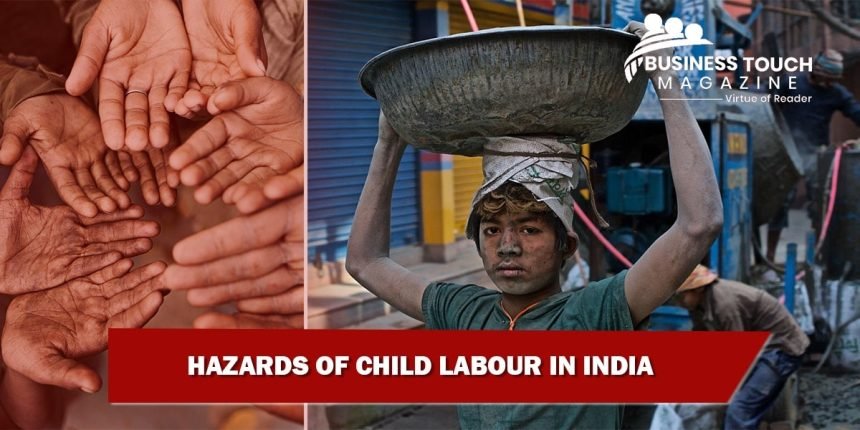Just hearing the term “child” evokes a picture of someone who enjoys spending time with his or her family or peers and who may easily find enjoyment in doing so. Social and family environments have an enormous impact on the development of a child’s mental and physical abilities. In the formative years of a child’s life, academic success, physical exercise, and social connection in a safe setting may all contribute to his or her physical and mental well-being. After all, a prosperous future may be ensured by a happy childhood. To put it another way, “kid labour” is a sharp contrast to all the ideals of childhood. Essentially, it is a profession that robs children of their youth, impedes their ability to attend a regular school, and is unsafe or damaging to their mental, physical or social well-being. Despite the fact that it is unethical, this practice is widespread in the Indian industrial sector.
India has more child labourers than any other country on Earth.
It is common for youngsters in India to start working at a relatively early age. In many cases, children must work as early as possible in order to support their families. In some instances, parents even expect their offspring to carry on the family business.
According to the 2011 census, there were 10.2 million “economically engaged” children in India between the ages of five and 14 – 5.6 million males and 4.5 million girls – with 8 million working in rural regions and 2 million in urban areas. Children working in rural areas decreased from 11 million to 8 million during the 2001 and 2011 censuses, although the number working in urban areas increased from 1.3 million to 2 million. According to Action Aid India, one in every eleven youngsters in India works to support themselves. Child labour is on the rise in India due to a lack of education, poverty, and a lack of public awareness. According to specific experts, the expansion of child labour in our nation may be slowed by an inclusive education system and a strict rule forbidding this practice.
Child labour has always been a concern in India, and the country has always taken a proactive approach to solve it. All of India’s constitutional and legislative provisions to eradicate child labour has always been in place. To ensure that all children have access to free and compulsory primary education, the Indian Constitution included essential measures in the Constitution.
Many youngsters begin working at an early age for economic reasons, but it also enables them to escape certain societal restrictions.
Indian Government policies on Child Labor in India
As a result, India’s stance on child labour has developed throughout time. Laws on child labour in India are based on pragmatism and are in accordance with the 1979 International Labour Conference decision on the subject.
Child labour is prohibited in all factories, mines, and dangerous jobs under the age of 14, and the government regulates the working conditions of minors in all other jobs. This is the primary goal of the Child Labor (Prohibition and Regulation) Act of 1986.
India’s child labour laws
The working circumstances of minors have been controlled in every employment that is not forbidden by the Child Labour (Prohibition Regulation) Act by a May 26, 1993 notice. The government has also forbidden hiring minors in occupations such as abattoirs/slaughter houses, printing, cashew nut descaling and processing, and soldering, after a preliminary notice issuance was done on October 5, 1993.
Some children work in industries, creating carpets and matches, while others live on plantations or stay at home and take care of the family.
Working long hours for little income is a big problem for boys since they frequently have to undertake physical labour outside of the house for little pay.
Child labour regulations have been enacted in India, notably the 1986 Child Labor (Prohibition and Regulation) Act, which specified that children under the age of fourteen might not work in dangerous jobs.
It also sought to control working conditions in the occupations it authorized and increased the importance placed on health and safety requirements via this legislation. These objectives, however, remain elusive owing to a combination of cultural and economic constraints. On the other hand, the statute does little to safeguard Indian children who undertake domestic or unreported work. Because they are seen as servants rather than employees, females are underutilized as workers in almost every Indian industry. As a result, the legislation does not provide any protection for females. Even if more is done, many Indian children will continue to live in poverty until there are changes made.
History has shown that child labour laws/policies have been ineffectual in fighting this problem, despite the fact that these measures may have favourable benefits. Our society’s socioeconomic realities must be addressed if we are to stop forcing children to work at such a young age, frequently in appalling conditions. Companies, in particular, take advantage of this small pool of workers because they lack the clout to demand higher compensation or more favourable working conditions.
As a result of their families’ poverty, many of these children are forced to labour. To establish a parallel economy based on an untrained and uncontrolled labour of minors, especially in a growing nation like India, is a disgrace and a threat to our country’s progress and future. Surely, there must be a way out of this gloom. How could one not?
Without a doubt, there is one.
An essential tool in the fight against child labour is social audits, which may be used with other methods like universal education and strict enforcement of child labour laws and regulations. Every company, big or small, must report on its corporate social performance in terms of occupational health and safety, employment opportunities for minorities, environmental degradation, and other issues. Writings from some of the world’s most famous authors An organization’s impact on society (i.e. on specific social groups) and the general well-being is described as a “systematic endeavour to identify, analyze, quantify (if practicable), assess, and monitor the influence of an organization’s activities on society.” As a result, a social audit is not only a list of the company’s social initiatives but a practical approach for identifying and determining the company’s social duties.
As we have learned, child labour in our nation has grown due to many malevolent circumstances. However, the moment has come to modify our society’s economic structure in order to secure a more promising future. In addition to making well-informed choices and increasing awareness, little steps like conducting social audits may help you get closer to your objective.
These are international norms that demand that companies not only restrict child labour but also offer an acceptable quality of life for all of their workers. In order to provide a pleasant working environment, manufacturers use these criteria. It reassures the public that firms are committed to upholding workers’ rights. International customers often seek these certificates to ensure that their items are not being manufactured in an unethical manner.




